The Dreamers of a decade ago are today teachers, nurses, journalists, lawyers — but still lack US citizenship
The DREAM Act was introduced in Congress in August 2001, and has still not been approved. This law would allow 3.5 million undocumented young people who arrived in America as minors to regularize their situation

Reyna Montoya is Mexican, Arizonan, DACA recipient and Dreamer. She has a degree in Political Science, a master’s degree in Education, and a certificate in Executive Education from the Harvard Kennedy School. She was listed by Forbes magazine as one of the 30 social entrepreneurs under 30, and is the president and founder of Aliento, an organization that guides, supports and educates young people on how to face and overcome the trauma that comes with being undocumented or being part of a mixed-status family. It supports young people like her, who have also been affected by the fact that the U.S. Congress, after two decades, has still not approved the DREAM Act, the dream that is never comes to fruition.
Since it was first introduced in the U.S. Congress in August 2001, the DREAM Act has failed to pass, irrespective of who has been in office. If it were passed, this law would allow 3.5 million undocumented young people who arrived in the United States as minors to regularize their immigration status with a temporary residence that would open the way to citizenship. It was voted on several times without success over a decade. And in December 2010, the DREAM Act passed the House of Representatives, but fell five votes short in the Senate — this was the closest it got to being approved.
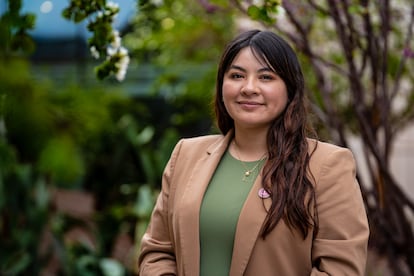
The outcome of the December vote — which was expected to be a historic win — pushed these young people to turn their frustration into action. With president Barack Obama — who promised regularization on the campaign trail — in the White House, social media giving undocumented kids the opportunity to organize remotely, and many universities in the country willing to support their students, the Dreamer movement came to the fore. The rest is history. Amid hundreds of civil disobedience actions documented by the media; demonstrations with the slogan “undocumented and unafraid,” and careful lobbying of state and federal congresses, the young Dreamers gained the sympathy of most Americans and created enough pressure so that, in 2012, Obama himself announced an executive order to protect them from deportation. This protection — Deferred Action for Childhood Arrivals program, commonly known as DACA — did not however grant them regular immigration status, which can only be approved by Congress.
Another decade has passed since then. The children who could have benefited from the DREAM Act, had it been passed in 2001, have been in limbo for more than 20 years. But they have not gone anywhere: today they are nurses, lawyers, journalists, social workers, teachers. Many are activists, who educate and create community; some work hand in hand with legislators, and many are parents of children and adolescents who were born in the United States.
On May 23, a visibly irritated Alex Padilla, senator for the state of California, explained to the media the reasons why he and a group of Democratic legislators broke from Democrats and voted against the border security initiative presented to the U.S. Congress by President Joe Biden.
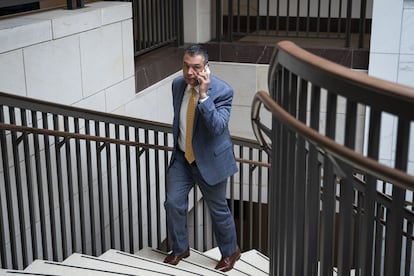
“This was the first time I can recall that Democrats almost unified behind anything (related to immigration or border policy) without fighting for protections for Dreamers or farmworkers or other long-term undocumented members of our community,” he said of the bill that was rejected for a second time, with only 50 votes in favor, far from the 60 needed to be passed. “So the Senate is voting on this package for a second time, but still no vote on the DREAM Act? It’s hard to swallow,” he said.
A painful fight
Reyna Montoya was born in Tijuana, Mexico. Her migration story began when she was 10 years old and her father was kidnapped. After being released, and knowing that one of his co-workers had suffered a different fate and had been murdered, the family decided to move to the Mexican city of Nogales, Sonora, on the border with Arizona. The next three years they lived in what Reyna calls “the space in-between”: her father lived on the U.S. side of the border, and she, her mother, and her brother, on the Mexican side.
“My mom would pick me up from school on Fridays and we would drive to see my dad. We stayed there for the weekend, and on Monday at 4 a.m. we returned and they left me directly in front of my school,” she remembers. Over time, his father bought a house in Mesa, Arizona, and the family migrated permanently using a tourist visa that they would later let expire, falling into the administrative category of “undocumented.”
In 2010, in what would be a watershed year, Reyna arrived at university and became involved in activism. In Arizona, the law SB 1070 had just been approved, which criminalized undocumented immigrants, and the young woman joined a group of undocumented students that mobilized against the initiative. The word “Dreamer” was not yet part of the political vocabulary, but groups like United We Dream, the largest activist organization for the rights of these young people, were already in action.
In the Dreamer movement there are usually abrupt ups and downs, and Reyna saw this firsthand when, after the triumph of the DACA announcement in 2012 — a measure that allowed the Dreamers to have a social security number and a permit job for two years — father was detained, and deportation proceedings were opened against him. At that moment, Reyna was 22 years old, her brother was 15 and her sister was five. Her mother was paralyzed, she did not know how to react. Reyna took on the responsibility of building a media campaign around her father’s case — just as she had learned to do in the movement — and a legal strategy to fight an asylum case that lawyers told her was nearly impossible to win.
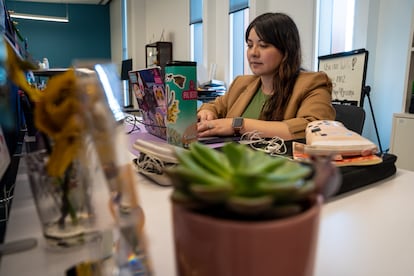
Looking back, Reyna — now 34 years old and with the same smile as the twenty-something Reyna who organized street protests — describes it as a time of great stress and anxiety. She had to look for lawyers, act as an interpreter, and at the same time organize her community to come together to stop her father from being deported. Her father won his asylum case in 2019, with Donald Trump in the White House, although he is still waiting for his green card five years later. But the effort involved in this kind of legal action takes a toll. Reyna knew how to manage the press and the legal side of the case, but no one had taught the Dreamers about mental health or self-care; they had to learn about it with the daily blows.
“No one in the movement asked me ‘as his daughter, how are you,’ and that hurt me on a personal level. I felt that no one cared about me as a human being, that they cared about me because I was an organizer, an activist, and had a story to tell,” she recalls. “It was indeed a very painful time. I was 23 years old and exhausted, with no resources to go to therapy, no access to health insurance. I knew I wanted to continue to support my community, but I thought it would have to be another way.”
So Reyna decided to make a change. She focused on contemporary dance, an activity that she practiced professionally and that helped her heal, and left United We Dream. She became a high school teacher in a predominantly Latino school and began to move past her two-decade long struggle, with all its ups and downs.
A growing generation
On Friday, June 15, 2012, a cry of euphoria was heard in tens of thousands of homes across the United States. President Obama had announced the DACA program, which granted temporary protection. “These are young people who study in our schools, they play in our neighborhoods, they’re friends with our kids, they pledge allegiance to our flag,” said Obama. Although this did not regularize the immigration status of the young Dreamers, it did give them the possibility of working legally and accessing financial aid to go to university. And they were quick to take advantage of the initiative.
In the United States, more than 800,000 young people have received DACA protection since it was introduced; currently, the number is about 600,000. In the past 12 years, almost half have completed university studies, and nine out of 10 are in the formal labor market. In 2018, the U.S. Census Bureau released figures on the workplaces that DACA recipients had joined: 77,000 worked in restaurants; 43,000 in the health or social care sector; 32,000 in supermarkets, pharmacies, and other businesses; 21,000 in small businesses and transportation of goods; 14,000 in the manufacturing sector; and 13,000 in cleaning and waste management. Two years later, when the Covid-19 pandemic hit, these would be the sectors that were considered “essential.”
These are not the only areas in which the Dreamers have become essential. In late 2017, with president Trump threatening to withdraw DACA protection, an alliance of 800 presidents and CEOs of technology companies — including Apple, Google, Amazon and Uber — sent a letter to the leaders of the U.S. Congress, demanding “the legislative solution that Dreamers deserve.” “Our economy would lose $460.3 billion from the national GDP and $24.6 billion in Social Security and Medicare tax contributions,” the signatories stated. The Trump administration backed off its intention to repeal DACA for people who were already recipients, but, via a court decision, it rejected new applications.
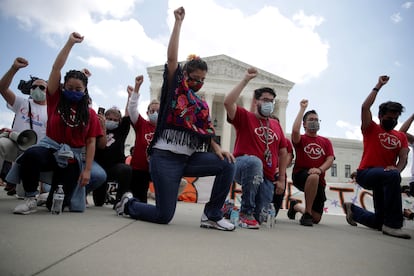
Numbers aside, what’s most moving is the story of these young Dreamers who have thrived thanks to DACA. This list includes people like Alma de Jesús and Alejandro Catalán, who joined the movement in 2003 and today have two teenage children. They were able to rent their own home, access credit cards, and raise their income. Brian de los Santos, who graduated with a degree in journalism 15 years ago, has been an editor at several media outlets, including the Los Angeles Times. Yunuén Bonaparte, who completed her university studies in California without financial aid, is today a successful photographer in New York. Lizbeth Mateo finished law school, joined the California Bar, and is dedicated to the regularization of undocumented immigrants.
The young people who were DACA recipients in 2010 have now become adults who have forged lives thanks to their effort and struggle. Many of them, now in their thirties, have children who are American citizens. Nearly 300,000 children and adolescents born in the United States have at least one parent protected by DACA.
The numbers and stories highlight why the DACA program should be maintained and expanded, and also why Congress should approve the regularization of the Dreamers. Even the U.S. public supports the move. According to surveys conducted over 15 years, three out of four Americans believe that undocumented adults who arrived in the country as children deserve such regularization. People recognize that these children are de facto Americans, and that they are only missing the document that puts it in writing “We should be better than this,” said Senator Padilla to a Congress that — regardless of the party with the majority — has avoided committing to any measure that implies immigration regularization, despite everything indicating that, in the case of the Dreamers, it would not cost votes.
“Dreamers are our loved ones, our nurses, teachers and small business owners. And they deserve the promise of healthcare just like all of us,” President Biden said a few weeks ago when announcing that DACA recipients would be eligible to access affordable healthcare services. DACA recipients today are barely a fifth of the entire population that could receive regularization with the approval of the DREAM Act.
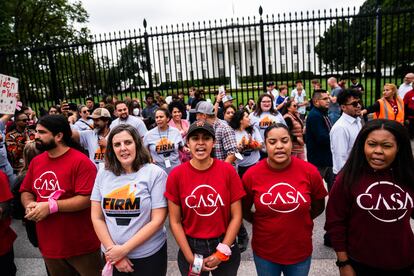
A breath of fresh air
Among the Dreamer success stories used to argue in favor of regularization, Reyna’s is undoubtedly one of the most iconic. When she became a high school teacher in 2013, she came into contact with a different community than the one she had known during her activist period. Here were young people without access to information, who did not know what DACA was, or who knew it, but were afraid to apply for it. Some were U.S. citizens but were afraid to apply for college funding because of their parents’ immigration status.
“I felt like I had been living in a bubble,” Reyna recalls. “I found young people who did not know what their rights were, nor how to navigate the system; I became the immigration teacher.” Once again, the path led Reyna to activism, but this time with a very clear idea: to address the issue of immigration, the pain of people whose relatives had been detained or deported needed to be recognized. There was a need for an initiative that prioritized the mental and emotional healing of people directly impacted by immigration policies, “with the hope of not only telling our stories, but of being the strategists of our own lives,” she explains. And so, in 2016, Aliento was born.
Eight years later, the focus of Reyna’s work through Aliento is on children and young people. With the support of the foundations that finance the project, Aliento has directly impacted the lives of more than 20,000 students and 50,000 people through its programs. As part of its work, Aliento promoted the in-state tuition initiative, which allows undocumented young people in Arizona to pay college tuition like any other legal resident — and not the high fees charged to foreign students. This will benefit 65,000 potential students who will be able to access scholarships at the local and state level.
Among the 14 people who make up Aliento’s staff, there are several who, like Reyna, are not yet American citizens and, therefore, cannot vote in the elections. What they can do, and do very well, is mobilize people to vote in favor of legislators and governors who can make things better for them. In the 2020 election, Aliento managed to involve 25,000 voters, and in 2022, more than 60,000. They were able to secure these tens of thousands of votes through phone calls, going door to door and making direct contact. This year, they’re aiming for an even higher number. That’s how the Dreamer movement continues to fight.
Sign up for our weekly newsletter to get more English-language news coverage from EL PAÍS USA Edition
Tu suscripción se está usando en otro dispositivo
¿Quieres añadir otro usuario a tu suscripción?
Si continúas leyendo en este dispositivo, no se podrá leer en el otro.
FlechaTu suscripción se está usando en otro dispositivo y solo puedes acceder a EL PAÍS desde un dispositivo a la vez.
Si quieres compartir tu cuenta, cambia tu suscripción a la modalidad Premium, así podrás añadir otro usuario. Cada uno accederá con su propia cuenta de email, lo que os permitirá personalizar vuestra experiencia en EL PAÍS.
¿Tienes una suscripción de empresa? Accede aquí para contratar más cuentas.
En el caso de no saber quién está usando tu cuenta, te recomendamos cambiar tu contraseña aquí.
Si decides continuar compartiendo tu cuenta, este mensaje se mostrará en tu dispositivo y en el de la otra persona que está usando tu cuenta de forma indefinida, afectando a tu experiencia de lectura. Puedes consultar aquí los términos y condiciones de la suscripción digital.
More information
Archived In
Últimas noticias
Welcome to the post-religion era: The idea of Christianity as the absolute truth has become obsolete
‘I thought you would like it’: The risky sexual practice popularized by TV shows and TikTok
The digitalization of tourism: ‘They promise experiences and gave us the worst possible one’
Mexican peso defies uncertainty with forecasts of a new period of stability in 2026
Most viewed
- Sinaloa Cartel war is taking its toll on Los Chapitos
- Oona Chaplin: ‘I told James Cameron that I was living in a treehouse and starting a permaculture project with a friend’
- Reinhard Genzel, Nobel laureate in physics: ‘One-minute videos will never give you the truth’
- Why the price of coffee has skyrocketed: from Brazilian plantations to specialty coffee houses
- Silver prices are going crazy: This is what’s fueling the rally










































